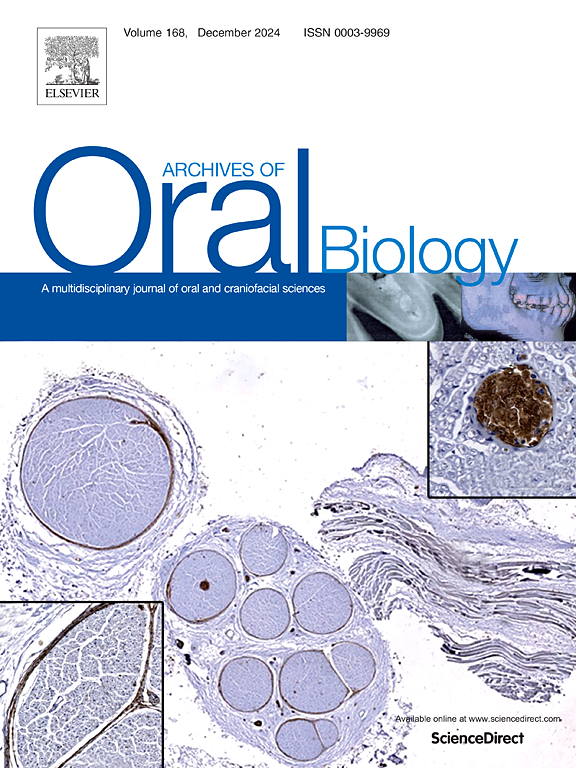代谢组学对特发性口腔干燥症的启示:咖啡因代谢在唾液生物化学中的核心作用
IF 2.2
4区 医学
Q2 DENTISTRY, ORAL SURGERY & MEDICINE
引用次数: 0
摘要
目的本研究旨在利用非靶向代谢组学技术描述特发性口腔干燥症患者的唾液代谢组学特征,以解决缺乏明确诊断标志物的问题,并深入了解该病症的病理生理机制。设计在这项观察性横断面研究中,使用超高效液相色谱-四极杆飞行时间质谱(UPLC-QTOF MS)分析了33名特发性口干症患者和34名健康对照者的唾液样本。代谢组分析辅以多元统计分析,以区分患者和对照组。共有 195 种代谢物显示出显著的差异表达,每种代谢物在预测中的可变重要性(VIP)均大于 1 且 P 值小于 0.05。根据《京都基因和基因组百科全书》(KEGG)进行的通路富集分析发现,有 22 种代谢物参与了 18 条不同的代谢通路。结论唾液代谢组学分析揭示了特发性口腔干燥症的明显改变,其中咖啡因代谢途径显著减少,突显了潜在的神经病理性参与。这项研究加深了我们对口腔干燥症代谢改变的了解,表明唾液代谢组学可为诊断和了解特发性口腔干燥症的病因提供可行的生物标记物。未来的研究应侧重于针对这些代谢紊乱的治疗,并评估其治疗后的可逆性。本文章由计算机程序翻译,如有差异,请以英文原文为准。
Metabolomic insights into idiopathic xerostomia: The central role of caffeine metabolism in salivary biochemistry
Objective
This study aims to delineate the salivary metabolomic profile of patients with idiopathic xerostomia using untargeted metabolomics techniques, with the goal of addressing the lack of clear diagnostic markers and providing insights into the pathophysiological mechanisms of the condition.
Design
In this observational, cross-sectional study, saliva samples from 33 patients with idiopathic xerostomia and 34 healthy controls were analyzed using Ultra Performance Liquid Chromatography Quadrupole Time of Flight Mass Spectrometry (UPLC-QTOF MS). Metabolomic profiling was complemented by multivariate statistical analysis to differentiate between affected individuals and controls.
Results
Metabolomic analysis delineated a pronounced differentiation between patients with idiopathic xerostomia and healthy controls. A total of 195 metabolites displayed significant differential expression, each with a variable importance in projection (VIP) greater than 1 and a P-value less than 0.05. Pathway enrichment analysis, according to the Kyoto Encyclopedia of Genes and Genomes (KEGG), identified 22 metabolites that participated in 18 distinct metabolic pathways. Among these, the caffeine metabolism pathway, characterized by notable alterations in impact values (VIP, P-value, Log2-fold change, Rich factor), emerged as the most significantly disrupted, underscoring its potential role in the pathophysiology of idiopathic xerostomia (P = 0.0000395).
Conclusions
The salivary metabolomic profiling revealed distinct alterations in idiopathic xerostomia, with a significant reduction in caffeine metabolism pathways, underscoring potential neuropathic involvement. This study advances our understanding of the metabolic alterations in xerostomia, suggesting that salivary metabolomics may offer viable biomarkers for diagnosing and understanding the etiology of idiopathic xerostomia. Future research should focus on therapeutic targeting of these metabolic disturbances and evaluating their reversibility with treatment.
求助全文
通过发布文献求助,成功后即可免费获取论文全文。
去求助
来源期刊

Archives of oral biology
医学-牙科与口腔外科
CiteScore
5.10
自引率
3.30%
发文量
177
审稿时长
26 days
期刊介绍:
Archives of Oral Biology is an international journal which aims to publish papers of the highest scientific quality in the oral and craniofacial sciences. The journal is particularly interested in research which advances knowledge in the mechanisms of craniofacial development and disease, including:
Cell and molecular biology
Molecular genetics
Immunology
Pathogenesis
Cellular microbiology
Embryology
Syndromology
Forensic dentistry
 求助内容:
求助内容: 应助结果提醒方式:
应助结果提醒方式:


